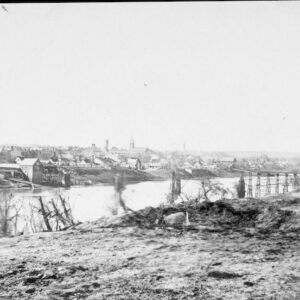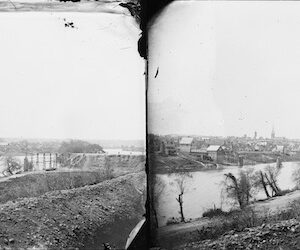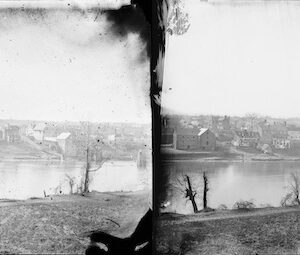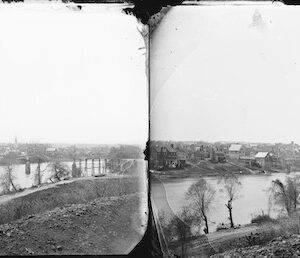| Credit: | by OSullivan (Timothy H.) |
|---|---|
| Date: | 1863.02 |
| Negative Size: | 8 in. x 10 in. |
| Locations & Lines: | Fredericksburg VA; Rappahannock River VA; Richmond, Fredericksburg & Potomac Railroad (RF&P); Virginia |
| Military Units: | CS Army; US Army |
| Structures & Establishments: | Court House (Fredericksburg VA); Fredericksburg Baptist Church (Fredericksburg VA); RF&P Bridge (Rappahannock River VA); St. Georges Episcopal Church (Fredericksburg VA) |
| Sources: | Boston Athenaeum; Library of Congress; National Archives; University of Maryland (Baltimore County); USAMHI – MOLLUS collection |
$6.99
File Details: AIKLm, 750 DPI, TIFF, Original Negative, 42.8 Mb
Image ID: AIKL
Gardner’s Photographic Sketch Book Of The War. Vol. 1, No. 30. Fredericksburg, Virginia. February, 1863. Just below the Falls of the Rappahannock, and midway between Washington and Richmond, is the city of Fredericksburg, the scene of the most thrilling events of the war. Nestled in a valley of unsurpassed fertility, its people had surrounded their homes with elegance, and enjoyed all that affluence could secure. The citizens were zealous advocates of secession, and, in 1861, the city was made a rendezvous for Confederate troops; but the first year of the war passed without a blow to mar its peaceful beauty. General Augur, in April, 1862, surprised and captured the place, which remained in our possession till the middle of summer, when Pope’s retreat from Cedar Mountain necessitated its abandonment. In November, the Army of the Potomac marched down from the Antietam campaign, but owing to delay in occupying the heights commanding the city, failed in capturing it, and encamped upon the hills north of the river, where the troops went into winter quarters, the Confederates, meanwhile fortifying the Fredericksburg heights, and rendering the position impregnable to assault. On the night of the 10th of December,the movements for an attack commenced. The artillery was planted along the river bank opposite the city, and about three o’clock on the morning of the 11th the pontoon trains came down the river. The engineers had constructed bridges about halfway across the stream, when the Confederate sharpshooters opened a sever fire from the houses and rifle pits, which was returned by our artillery, numbering about seventy guns. The bombardment lasted throughout the day, with frequent intervals to enable the engineers to resume work. but who were invariably driven off with considerable loss, until late in the afternoon, when a storming party crossed in boats and drove out the riflemen. A small portion of the troops occupied the town that night, and next day was followed by the whole army, the Confederates offering no resistance except by occasional shots from their artillery on the heights. The troops were formed for assault, with the right resting on the Rappahannock, one mile above the city, the lines extending in a semi-circle around the town, to a point three miles below, where the left also joined the river. Early on the morning of the 13th, the battle commenced, lasting all day, with fearful loss on our side, and night closing the struggle with both armies occupying the same positions taken in the morning. Sunday and Monday passed without anything transpiring except skirmishing along the lines, and Monday night, under cover of a pitiless storm of rain and sleet, our troop returned to their camps.
During the Wilderness campaign the city was again occupied by the Union army for a short time. The ruin, commenced in the battle of December, was complete before the close of the war, and at the termination of hostilities little remained of the city but deserted houses and tottering walls; but now business is resumed with an activity that betokens a brilliant future.
Etched onto negative: 2098 [crossed out]. 7927.





